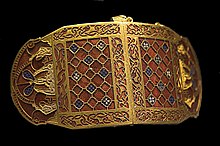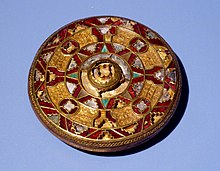Anglo-Saxon dress
Religious art, symbols and writings from the conversion years greatly influenced costumes from this period onward, especially women's dress and jewellery.
Clothing worn by the military, the elite class and religious orders was initially similar to the daily garments of the common man and woman.
Over time, and with the influence of European culture, the spread of Christianity and the increasing prosperity of Anglo-Saxon England, garments and accessories specific to each group became the standard by which they were identified.
Higher-status individuals typically owned multiple items of clothing and accessories, often made with high-quality and expensive materials, and decorated in intricate detail.
Beginning in the eighth century, grave-goods, except for simple items like knives and belts, were no longer included with individual burials.
This lack of costume artefacts makes it more challenging for historians and archaeologists to determine what Anglo-Saxons were wearing during the eighth to the eleventh centuries.
[8] Fifth and sixth century women's costume has been reconstructed by scholars, based on the archaeological evidence of brooches worn in pairs at the shoulders.
[10] Dress and accessories, specifically the peplos, the pin, a belt or girdle with tools and keys, was relevant to a woman's age and state of life, especially to the child-bearing years and marriage.
"[14] There were other regional variations of women's dress, notably in Anglian areas, where wrist clasps and a third, central brooch and distinctive 'girdle-hangers' were the norm.
[5][15] The typical women's costume of this era was a long peplos-like garment, pulled up to the armpit and worn over a sleeved under-garment, usually another dress.
[4] Along with the spread of Christianity in seventh century England, religious art and European fashion inspired changes in women's dress.
Amethyst beads started appearing at this time, along with necklaces of gold and silver wire, and, as a symbol of being Christian, small jewelled crosses.
[25][26] In the tenth and eleventh centuries, the growth of cities throughout England expanded the variety and quantity of textiles, clothing, and accessories that were made available to Anglo-Saxon women.
With the introduction of the warp-weighted loom in (c. 200 AD), wool clothing would have been available for men and may have replaced or diminished the reliance on fur and skin garments.
Men wearing similarly styled cloaks, clasped with circular brooches, occur in late era Anglo-Saxon drawings and paintings.
Male burial artefacts from the fifth to the seventh centuries rarely include brooches; any metalwork uncovered have usually been pins found in the chest area of the body.
Clasps were not needed to hold the tunic together because when pulled over the head it would sit snugly around the neck without the use of lacing or ties, indicating that the garment was one continuous piece.
Ankle-length trousers are also seen on Roman sculptures of Germanic men, often with a short tunic, tied around the waist with a belt or draped with a cloak.
It is likely that Anglo-Saxons, especially agricultural labourers, went barefoot, although linguistic documentation has revealed that there were several shoe types in circulation during this time period: slippers, raw-hide pampooties and pouch-like foot coverings.
[43][44] Writings of an eighth century historian, Paulus Catena, describe Germanic peoples inhabiting the Italian Peninsula during this time period, "Indeed their clothes were roomy and especially linen, as the Anglo-Saxons were accustomed to have, embellished with rather wide borders woven in various colours" Paulus's description of Anglo-Saxon wearing linen is confirmed by eighth century writers, Bede and Aldhelm.
Letters between King Offa of Mercia and the Frankish Emperor Charlemagne demonstrate that clothing in Anglo-Saxon England was similar to Carolignian Frankia.
Flat, black shoes with a white stripe on top are the typical male footwear seen in Anglo-Saxon art during this time period.
Most of these extravagant items were primarily used as religious garments, but it is also highly likely that royals and the wealthier members of Anglo-Saxon society owned opulent and expensive clothing.
[72] Pile woven cloaks, which probably imitated fur in their shaggy effect, were a high status alternative for men in the seventh century.
[73] The extremely affluent male buried AD 625 in the Sutton Hoo Ship Burial (mound 1) was supplied with two pairs of shoes, several yellow-dyed cloaks, and possible alternative sets of jewelled belt equipment.
The artefacts were analysed and later interpreted to be the front borders of a wrap-over fighting jacket, as seen on the Sutton Hoo helmet panels and other 7th century art.
[80] Historians believe that Anglo-Saxon soldiers wore wrap-over, knee-length coats decorated like chain mail with sleeves that narrowed at the wrists.
[82] Weapons and clothes fittings worn on the battlefield were highly decorated with jewellery techniques, as seen in the discoveries at Sutton Hoo and in the Staffordshire Hoard; the concept of parade wear did not exist for the Anglo-Saxons.
[83] The clergy of the 11th century had shaved heads and wore hats which, according to Planché, were "slightly sinking in the centre, with the pendent ornaments of the mitre attached to the side of it".
[85] According to Owen-Crocker, "Linen production was a longer process, involved planting flax seed, weeding, harvesting, removal of seed pods, retting (rotting) the woody stems in water or a dewy field, drying, beating, and 'scrutching' the flax stems to break them and release the fibres inside, then repeated heckling or combing of those fibres to prepare them for spinning.


















